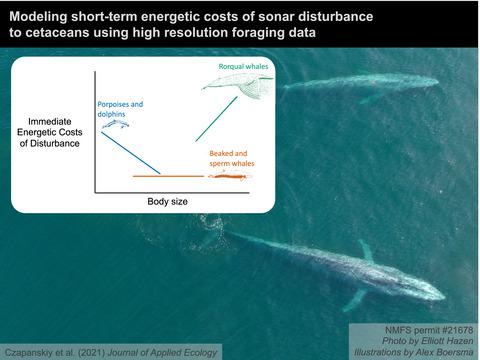当前位置:
X-MOL 学术
›
J. Appl. Ecol.
›
论文详情
Our official English website, www.x-mol.net, welcomes your feedback! (Note: you will need to create a separate account there.)
Modelling short-term energetic costs of sonar disturbance to cetaceans using high-resolution foraging data
Journal of Applied Ecology ( IF 5.7 ) Pub Date : 2021-05-25 , DOI: 10.1111/1365-2664.13903 Max F. Czapanskiy 1 , Matthew S. Savoca 1 , William T. Gough 1 , Paolo S. Segre 1 , Danuta M. Wisniewska 1, 2 , David E. Cade 1, 3 , Jeremy A. Goldbogen 1
中文翻译:

使用高分辨率觅食数据模拟声纳干扰对鲸类的短期能量成本
更新日期:2021-05-25
Journal of Applied Ecology ( IF 5.7 ) Pub Date : 2021-05-25 , DOI: 10.1111/1365-2664.13903 Max F. Czapanskiy 1 , Matthew S. Savoca 1 , William T. Gough 1 , Paolo S. Segre 1 , Danuta M. Wisniewska 1, 2 , David E. Cade 1, 3 , Jeremy A. Goldbogen 1
Affiliation

|
- Anthropogenic noise is a pervasive and increasing source of disturbance to wildlife. Marine mammals exhibit behavioural and physiological responses to naval sonar and other sound sources. The lost foraging opportunities and elevated locomotor effort associated with sonar disturbance likely carry energetic costs, which may lead to population-level consequences.
- We modelled the energetic costs associated with behavioural responses using (a) empirical datasets of cetacean feeding rates and prey characteristics and (b) allometry of swimming performance and metabolic rates.
- We applied our model to compare the short-term (i.e. the scale of the disturbance response; hours to days) energetic costs of a variety of observed behavioural responses. Efficient foragers (e.g. baleen whales) incur a greater relative energetic cost for mild behavioural responses as compared to the most extreme observed response for larger odontocetes (e.g. beaked whales). Energetic costs are more sensitive to lost feeding opportunities than increased energy expenditure from elevated locomotor effort.
- To scale up from short-term costs to long-term effects (months to years), future research should address individuals’ capacity to compensate for energetic losses as well as energetic thresholds for demographic rates (survival, fecundity). We discuss how relative energetic costs correlate with species’ pace of life and the implications for conservation planning.
- Synthesis and applications. Current approaches towards understanding the Population Consequences of Disturbance (PCoD) often must rely on expert opinion due to data deficiency. Our model provides an empirical method for linking behaviour to energetics, which is critical for managers to make informed decisions on actions that may affect marine mammal species. Furthermore, our model is applicable to other forms of disturbance, such as vessel traffic or seismic exploration, and our scaling approach enables risk projections for understudied species.
中文翻译:

使用高分辨率觅食数据模拟声纳干扰对鲸类的短期能量成本
- 人为噪声是对野生动物的一种普遍且日益增加的干扰源。海洋哺乳动物对海军声纳和其他声源表现出行为和生理反应。与声纳干扰相关的失去觅食机会和增加的运动努力可能会带来能量成本,这可能会导致种群水平的后果。
- 我们使用(a)鲸类摄食率和猎物特征的经验数据集和(b)游泳表现和代谢率的异速生长模拟了与行为反应相关的能量成本。
- 我们应用我们的模型来比较各种观察到的行为反应的短期(即干扰反应的规模;数小时到数天)能量成本。与观察到的较大齿鲸(例如喙鲸)的最极端反应相比,高效觅食者(例如须鲸)的温和行为反应会产生更大的相对能量成本。与因运动努力增加而增加的能量消耗相比,能量成本对失去进食机会更敏感。
- 为了从短期成本扩大到长期影响(几个月到几年),未来的研究应该解决个人补偿能量损失的能力以及人口比率(存活率、繁殖力)的能量阈值。我们讨论相对能量成本如何与物种的生活节奏以及对保护规划的影响相关联。
- 合成与应用。由于数据不足,当前理解人口扰动后果 (PCoD) 的方法通常必须依赖专家意见。我们的模型提供了一种将行为与能量联系起来的经验方法,这对于管理者就可能影响海洋哺乳动物物种的行动做出明智的决定至关重要。此外,我们的模型适用于其他形式的干扰,例如船舶交通或地震勘探,我们的缩放方法可以对未研究物种进行风险预测。



























 京公网安备 11010802027423号
京公网安备 11010802027423号